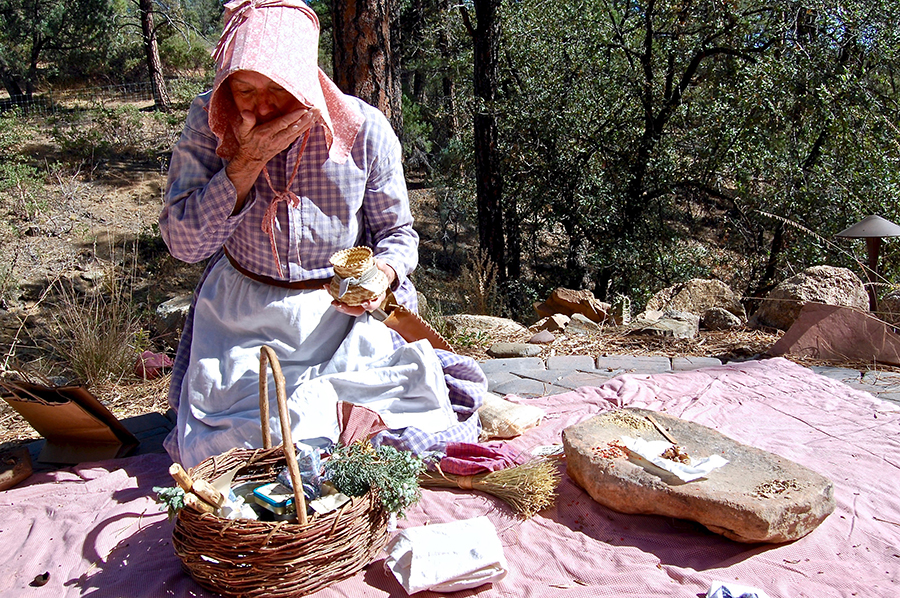By Joanna Dodder Nellans
Faith Roelofs lifted her basket and removed several Central Highlands plants as she described their uses: piñon pine needles for making cough syrup, honey for dressing wounds, Mormon tea for congestion, and willow bark for pain relief and inflammation. Her salve was made of piñon pine tree resin, beeswax and lard. The moldy bread served as an antibiotic on wounds and infections.
Faith was sitting in the Highlands Center for Natural History’s new Discovery Gardens “Secret Nook” during the center’s first Ethnobotany Fest Oct. 21. She was re-enacting Mary Ramos, one of only two women to call Prescott home in the year of its founding in 1864. She wore traditional farm clothing from that period including a bonnet, long-sleeved shirt, long loose skirt and apron.
Faith invited Ethnobotany Fest visitors to pick something from her basket to learn more.
“We like to be up close and personal with our groups,” she explained. “This is about our heritage, and how we can share it with others.”
Ethnobotany is the study of how people of a particular culture and region use native plants. From her arrival in Prescott in 1864 until her death at age 56 in 1876, Mary Ramos was known as someone who helped others in need of food or treatment. So she surely knew how to use local plants for a variety of needs in this wilderness capital.
“Ramos was noted for great kindness and generosity,” her newspaper obituary said. “Hundreds of the early settlers of this portion of Arizona can attest her noble generosity and kindness of heart, in dividing with the hungry and distressed.”
Faith seems to embody the persona of Mary Ramos, especially after portraying her for two decades now. In 1864, Mary established Prescott’s first boarding house in a small cabin along Granite Creek. The cabin later became known as “Fort Misery” and then fell into disrepair until 1934, when the late Sharlot Hall moved it to the grounds of the museum she founded several blocks away and restored it. Today it is the oldest standing log cabin in Arizona.
After running the boarding house for several years, Mary and her husband moved out to the country to raise goats and mine along Lynx Creek. Her home remained a popular stopping point for travelers.
“I totally love it because I identify with this lady,” Faith explained. “I had a country upbringing and understand how hard it is.”
Faith grew up on 17 acres outside of Ithaca, N.Y., where she walked to a one-room country school and spent summers roaming the woods on horseback – after finishing her chores, of course.
“We didn’t go swimming until we pitched manure,” she related.
Faith has volunteered countless hours portraying Mary at the Highlands Center and at the Schoolyard Habitats that the Highlands Center established at 10 local schoolyards. Faith’s generous donation helped pay for the Ethnobotanical Gardens in the Discovery Gardens, featuring educational signs next to native plants that explain their uses for medicines, food and supplies.
“Seeds contain complete protein and are high in calories, making a nutritious food for people and animals,” the sign next to a piñon pine reads. “Resin protects sores and cuts from exposure, and when melted is used to waterproof woven baskets. Pine needle extract treats headaches, coughs and fevers.” (Continued on next page)
The Ethnobotany Fest was the first of many nature festivals planned at the new Discovery Gardens, said Dave Irvine, Highlands Center for Natural History executive director.
‘This is an environmental learning center, so we want to educate people about plants here,” said Laura Councilor, education coordinator at the center. “Teaching their uses is one way to cultivate interest and knowledge.”
At the Ethnobotany Fest, Jo Schultheiss led guided ethnobotanical walks through the gardens and Diane Vaszily gave presentations about making poultices, ointments, and tinctures. Children enjoyed making crafts out of pinecones and other natural objects at a crafts table in the Forest Play area, while Kris Vaughn of the Herbal Wisdom Institute brought edible creations featuring local plants.
“I really like that,” youngster Iris Coble said after testing the acorn bread and prickly pear jelly at the Herbal Wisdom table.
Kris then demonstrated how to remove prickly pear needles from pads. She immersed the pads in a bowl of cold water, shaking them around before rinsing. Then she used a toothbrush to scrape off some of the needles, burned off more with a fireplace lighter, and scraped off the rest with a knife. She scored them and squeezed on fresh lime juice, then doused them with a bit of sea salt before grilling them to remove any needle remains.
“It’s really important as herbalists that we share these traditions,” Kris explained.
And interest in learning these traditions has been on the rise the past five years, she added.
The Highlands Center continues to help fuel that interest with its Ethnobotanical Gardens and guided tours.

